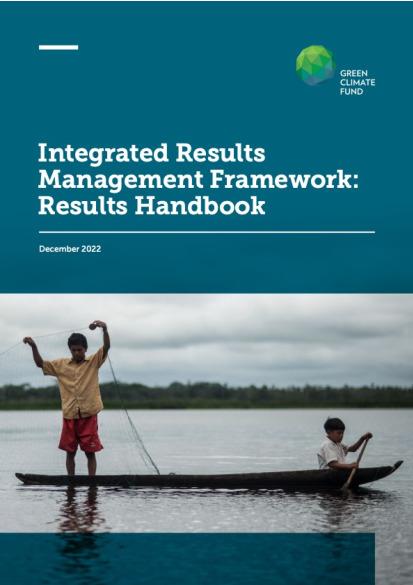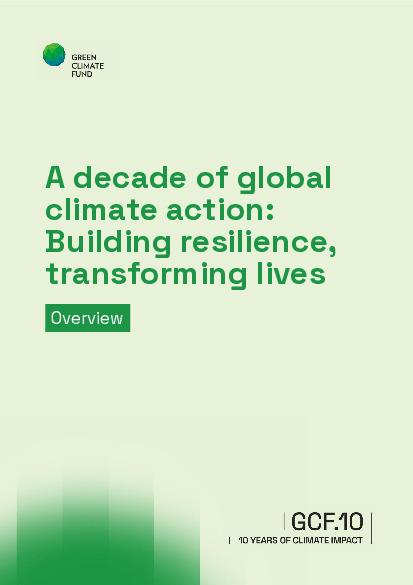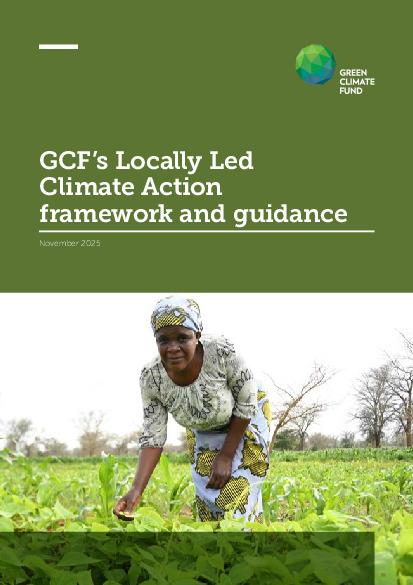Publications
The Green Climate Fund issues a range of publications for our direct and indirect stakeholders on a diversity of issues – for the general public to industry experts. Stay in tune with our mission and activities around the planet with the issues that speak to you.
Featured publications
GCF.10 Impact Report: Overview
A decade of global climate action: Building resilience, transforming lives
Read moreGCF’s Locally Led Climate Action framework and guidance
This document elaborates guidance on advancing good locally led practices through GCF modalities. Part 1 introduces GCF’s parameters and approach to devolution in the GCF business model and elaborates approaches for context-specific models. Part 2 provides step-by-step guidance for developing and structuring funding proposals in alignment with the parameters. A set of annexes cover Readiness, local, traditional and Indigenous knowledge, a related checklist and relevant examples from GCF portfolio.
Read moreCountry platforms for climate finance
This brochure describes GCF’s approach to country platforms, including an overview of the concept, the potential impact and the end-to-end support GCF can provide.
Read moreClimate investment planning and mobilization framework
The Green Climate Fund (GCF) and the NDC Partnership proudly launched the Climate Investment Planning and Mobilization Framework (Framework) to support countries in achieving national climate action. It aims to provide a common reference point fo
Read moreAnnual Progress Report 2024
This report describes the progress made by GCF to accelerate climate action for and by developing countries.
Read more
GCF in Brief: Simplified Approval Process
May 2022
The Green Climate Fund is moving quickly to build a large and transformative project portfolio, with many projects already under implementation. To simplify and streamline the approval of certain small scale projects, GCF’s Board has approved a new approach: the Simplified Approval Process (SAP). The simplifications in this new approach should lead to a reduction in time and effort required to go from project conception to implementation.

Draft results handbook
May 2022
Targeting accredited entities and executing entities as its primary audiences, the GCF’s results handbook aims to provide practical guidance on how to apply the IRMF for GCF-funded projects/programmes through funding proposal development, planning, monitoring, and reporting activities, as well as interim and final evaluations. The handbook defines each IRMF indicator and its measurement approaches with tools and reporting formats where applicable. As per the Board decision on the IRMF (...

Annual Results Report 2021
April 2022
Annual Results Report 2021: Promoting low emission, climate-resilient recovery and maintaining climate ambitions during the pandemic. GCF's annual report, available in both web and pdf versions, provides an overview of our achievements during 2021. The year 2021 continued to be a period of uncertainty and upheaval for the world, but it was also a year wherein the Green Climate Fund (GCF) made huge strides in supporting low emission, climate-resilient development pathways. Nearly USD 3 billion...

GCF handbook: Decisions, policies and frameworks (updated March 2022)
March 2022
The purpose of the “GCF Handbook” is to make it easier for users to more easily navigate the GCF’s decisions and policies. To facilitate this, each primary Board decision and related policy framework has been given a descriptive title, and placed within one of ten issue oriented chapters. There, the decisions and related frameworks have been further divided by sub-issue with the most recent action on any topic listed first. The decisions and related frameworks that are particularly policy rich...

ASEAN Catalytic Green Finance Facility (ACGF)
February 2022
Economic growth in developing countries in Southeast Asia must be de- coupled from carbon emissions to support the climate transition. In the Philippines, Indonesia, and Malaysia, fossil fuels dominate the power supply, and there is an increasing demand for passenger and freight transport. Deforestation and forest degradation continue to destroy critical carbon sinks across Cambodia, Indonesia, and Lao PDR. Southeast Asia also presents fast-changing climatic vulnerabilities, with average...

The Global Subnational Climate Fund (SnCF GLOBAL)
February 2022
Climate action means local action: 70% of climate solutions fall under the boundaries of sub-national authorities. But there is a chronic shortage of private finance for such local solutions, since investors prefer larger investments that are perceived as safer. Structuring and de-risking sub- national projects is essential to catalyse funding from both private and public investors.

GCF in Brief: Direct access
December 2021
One of the Green Climate Fund’s distinctive features is the provision for developing countries to access financial resources through national entities, meaning that climate finance can be channelled to the country directly. This factsheet explains how direct access works and the support provided for direct access Accredited Entities.

GCF in Brief: Complementarity and coherence
December 2021
GCF is committed to ensuring that our activities complement those of other funds, and that together we have a coherent approach to supporting the climate ambitions of developing countries. Complementarity refers to synergies among the various climate funds’ activities in similar sectors and themes (adaptation or mitigation), and even across regions of similar characteristics, with the aim of scaling up transformative actions. Coherence is about using country programming to seek alignment with...

Accelerating and scaling up climate innovation: How the Green Climate Fund’s approach can deliver new climate solutions for developing countries
November 2021
Climate innovation is critical to avert catastrophic climate change, but investment in new climate solutions is hampered by a range of barriers. This Working Paper first identifies the main barriers to climate innovation in developing countries, focusing on each stage of the innovation chain, from the emergence of innovation to its deployment and eventual widespread adoption. Many of these barriers are related to the policy and regulatory environment as well as to technical and macro-economic...

Towards a Long-Term Vision on Complementarity GEF and GCF Collaboration
November 2021
This document presents a Long-Term Vision on Complementarity and Coherence collaboration between the Green Climate Fund (GCF) and the Global Environment Facility (GEF), herein after referred to as LTV. This new vision aims to build on the Pilot Coordinated Engagement exercise the GCF and GEF have been carrying out since 2018, and further define specific areas of cooperation, where complementarity of action might be most efficient and effective, and possible modalities to generate long-lasting...

Enhancing Direct Access Guidelines
November 2021
The Green Climate Fund (GCF), Enhancing Direct Access (EDA) pilot intends to boost access by sub-national, national and regional, public, and private entities to GCF climate finance. EDA promotes country ownership of projects and programmes and devolves decision-making to local actors. This publication provides non-prescriptive guidance about how to structure an EDA Pilot intervention. It is primarily intended to support GCF Direct Access Entities (DAEs), National Designated Authorities and...

Upscaling climate resilience measures in the dry corridor agroecosystems of El Salvador (RECLIMA)
October 2021
Located in the dry corridor of Central America, El Salvador is one of the most vulnerable countries to climate risks in the world. At present, it is already facing water stress, with the per capita availability of freshwater well below the critical threshold of 1,700cubic metres per capita per year. Projected increases in the variability of rainfall, temperature, and occurrence of extreme weather events threaten the food and water security of farming ...

Thematic brief: Oceans
October 2021
Oceans and coastal ecosystems cover more than 70 percent of the Earth’s surface, providing a natural asset of enormous significance to protect our planet, preserve and enhance local economic growth, promote regional stability and conserve global biodiversity. This generates vital ecosystem goods and services that support our future, such as climate and temperature regulation, absorption of carbon emissions, fisheries, food security, coastal protection, tourism services and jobs. Marine...

Thematic brief: Leveraging equity finance to scale up climate innovation & investment
October 2021
Over the past decade, blended finance – which uses public funds to share risk and crowd-in private investment through co-financing - has usually taken the form of relatively safe senior debt rather than more risky instruments such as equity or guarantees that could have higher leveraging ratios and better meet the needs of private investors to finance the emergence, deployment and widespread adoption of new climate solutions. Equity is essential for young companies, particularly in developing...

Thematic brief: Agriculture and food security
October 2021
Farmers are facing unprecedented interlinked global shocks and challenges that threaten the gains in global food security and poverty reduction in recent years. Since most agriculture is rainfed in developing countries, climate change directly impacts agriculture by increasing temperatures and changing when and how much it rains. Most of the seeds, animals, and farming practices providing the world’s food are less productive as the climate changes, having been developed for past climates. Hence...

Cooling facility
October 2021
As global temperatures increase and the demand for cooling rises, so do the emission levels of greenhouse and fluorinated gases, which have a very high global warming potential. Reports cite that at 1.5°C of warming – a threshold that could be reached by 2030 - 2.3 billion people could be vulnerable to illness and death from heatwave events (Intergovernmental Panel on Climate Change, 2019) and productivity loss could be the equivalent of 80 million full-time jobs (International Labor...

Global fund for coral reefs investment window (GFCR)
October 2021
Coral reefs are among the world’s most threatened ecosystems by climate change impacts. And drivers such as overfishing, agricultural run-off, sewage discharge and unsustainable tourism degrade the coral reefs, further decreasing their chance of survival. Studies have shown that local management of such threats can alleviate the impacts of climate change on the coral reefs. Thus, supporting and providing capital to businesses and companies for the sustainable use of ocean resources can...

The Amazon bioeconomy fund
October 2021
Home to the world’s largest tropical forest, the Amazon is highly vulnerable to climate change impacts. The combination of increased temperatures and human-induced deforestation are creating adverse climate feedback loops. Increasingly warmer and drier conditions will further result in forest degradation and loss of ecological functions, ultimatelybringingtheAmazonforeststothepointofnoreturn. Known as the tipping point, there may come a time when the forests die and are replaced by dry savannah...

Thematic brief: Adaptation
October 2021
The Green Climate Fund (GCF) is committed to investing in developing countries’ efforts to adapt to the effects of climate change. GCF is delivering on our targets for adaptation and resilience by ensuring a 50/50 balance in allocation of funding between mitigation and adaptation projects, with over 50% of adaptation funding going to Least Developed Countries (LDCs), Small Islands Developing States (SIDS) and African States. The Fund is uniquely placed to attract private investment by de-...

SAP Compendium
September 2021
A key element that drives the simplification of the preparation of a SAP proposal is the clarity, at the onset, of what are the activities that can be eligible for the GCF simplified approval. This is one of the main elements that this Compendium offers to all those involved in originating a SAP intervention. If you work in a GCF Accredited Entity, or if you are a GCF National Designated Authority or Focal Point, or a consultant involved in preparing a GCF SAP project, thisCompendium is ...





